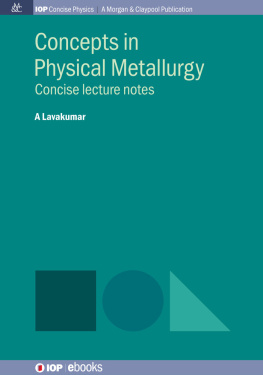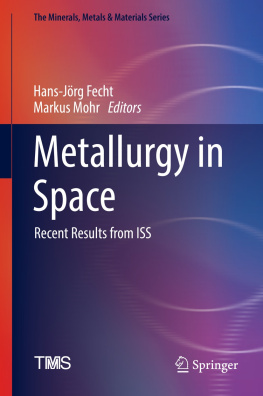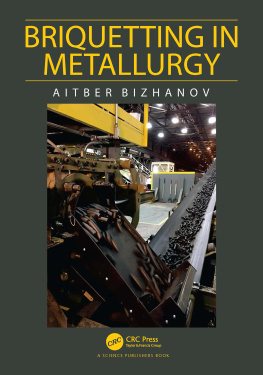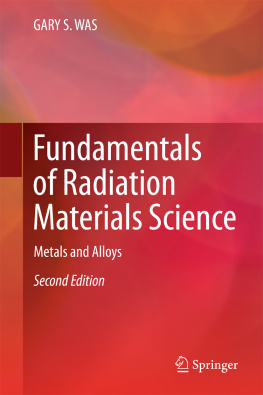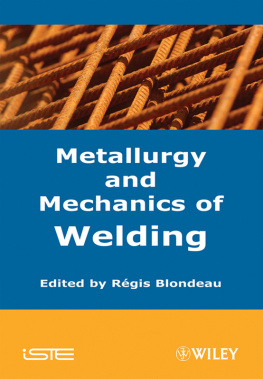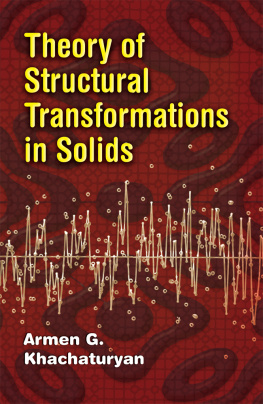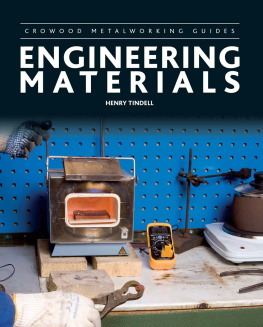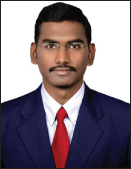Contents
Contents
Concepts in Physical Metallurgy
Concise lecture notes
A Lavakumar
Veer Surendra Sai University of Technology, Odisha, India
Morgan & Claypool Publishers
Copyright 2017 Morgan & Claypool Publishers
All rights reserved. No part of this publication may be reproduced, stored in a retrieval system or transmitted in any form or by any means, electronic, mechanical, photocopying, recording or otherwise, without the prior permission of the publisher, or as expressly permitted by law or under terms agreed with the appropriate rights organization. Multiple copying is permitted in accordance with the terms of licences issued by the Copyright Licensing Agency, the Copyright Clearance Centre and other reproduction rights organisations.
Rights & Permissions
To obtain permission to re-use copyrighted material from Morgan & Claypool Publishers, please contact .
ISBN 978-1-6817-4473-5 (ebook)
ISBN 978-1-6817-4472-8 (print)
ISBN 978-1-6817-4475-9 (mobi)
DOI 10.1088/978-1-6817-4473-5
Version: 20170401
IOP Concise Physics
ISSN 2053-2571 (online)
ISSN 2054-7307 (print)
A Morgan & Claypool publication as part of IOP Concise Physics
Published by Morgan & Claypool Publishers, 40 Oak Drive, San Rafael, CA, 94903 USA
IOP Publishing, Temple Circus, Temple Way, Bristol BS1 6HG, UK
Dedicated to my friends Ranga Nikhil Vinayak and Aksharitha Sribasyam
Preface
Developments in the science of metals have made the progress of the human race faster through the ages. In this context, the understanding of the structureproperty relationship of metals and alloys has become increasingly important. The large domain of the use of materials has made material science a multidisciplinary study. This book delivers an effective way to understand and realize the behavior of the materials right from the atomic level.
The first chapter describes the need for material science in the modern age and also explains some elementary facts regarding this book. The way atoms are arranged in metallic materials and the importance of symmetry in materials are described in chapter .
United we stand, divided we fallthis proverb denotes the strength of a collaboration. In the same manner metals require combinations in order to improve their strength and properties by the method of alloying. Chapter is intended to explain the fundamentals of alloying.
Phase diagrams are the indispensable tools in the field of metallurgy. They provide a medium for understanding the different possible phases of pure metals and alloys under the influence of external agents such as temperature and pressure. Chapter in this book explains the different types of phase diagrams in binary alloy systems.
Chapter is about the metallurgy of ferrous metals. Ferrous metals, i.e., steels and cast irons are the most widely used alloys, and therefore it is important to understand the basics about the heat treatment techniques of steels and cast irons.
Apart from the ferrous metals, various nonferrous metals are also being used for various applications. The last chapter, chapter , gives a brief idea about some commonly used nonferrous metals.
Acknowledgments
Throughout the process of writing this book, many individuals have taken time out to help the author. The author would like to give special thanks to his mentors Professor Viplava Kumar, Dr N Eswar Prasad, Professor Anandh Subramanian and Professor B S Murthy who have shaped the way I think as an engineer/teacher.
First, the author thanks D Narsimhachary, Srivastava, Trinath for actively participating in the feedback and editing of this book for quality improvement and the author wishes to acknowledge Soumya Sourav for sketching some of the figures for this book.
The author would extend his gratitude to Vice-Chancellor Professor E Sai Baba Reddy VSSUT, Odisha, Dr S K Badjena (Head, MME), Dr C Sasi Kumar (MANIT, Bhopal) for their constant support. Special thanks go to friends P K Singh, Nikhil Kulkarni, Abhinay, P K Katiyar, Rita for their support and encouragement during the course of this book.
The author would like to thank his colleagues and students in VSSUT, Odisha and MANIT, Bhopal for their useful discussions.
Finally, he gratefully thanks his beloved family for all their encouragement and support during the writing of this book.
A Lavakumar
Author biography
Avala Lavakumar
Avala Lavakumar is a physical metallurgist from the Department of Metallurgy and Materials Engineering, Veer Surendra Sai University of Technology, Odisha, India. He has a Bachelors Degree in Metallurgy and Materials Engineering from the J.N.T.U (M.G.I.T) Hyderabad, India and a Masters degree in industrial metallurgy from National Institute of Technology, Durgapur. He has research experience in RCMA (Materials), D.R.D.O. (Hyderabad) and has worked as an Assistant Professor in M.A. (National Institute of Technology, Bhopal, India). He is currently working as an Assistant Professor in Veer Surendra Sai University of Technology (V.S.S.U.T), Odisha, India. His primary research areas are indentation creep, phase transformations of steels, Al-alloys and super alloys, and their mechanical behavior.
IOP Concise Physics
Concepts in Physical Metallurgy
Concise lecture notes
A Lavakumar
Chapter 1
Introduction
1.1 The impact of materials on progress
Humans have evolved through many metal ages. The progress that human civilizations have made can, in part, be attributed to their learning to use various kinds of metals. Thus metallurgy can be considered as an ancient form of technology that has made our way of life more sophisticated and developed.
The beginning of the Industrial Revolution caused rapid growth in the production of iron and steel. Vast infrastructural developments took place due to improvements in metallurgy and materials science. It was thus at this time that metals and alloys, in particular steel, replaced wood as the principal structural material. The rapid developments in manufacturing, and the automotive and textile industries were also the result of the new large-scale steel production.
On the eve of the twentieth century, we had copper, bronze, iron, steel, aluminum and rubber, in addition to wood, to use as structural materials. This paved the way for a series of inventions leading to a paradigm shift in road transport, from horse-drawn carriages to motorized vehicles. In the present day, innovations in materials technology have resulted in the development of light-weight alloys and composites. Automotive engine components have traditionally been made from ferrous alloys, but the emphasis on weight reduction for higher fuel efficiency has increased the use of aluminum for cylinder blocks, cylinder heads and other engine components. Some engine covers and intake manifolds are made of magnesium. Titanium is also used in the connecting rods of high-speed engines to reduce the reciprocating mass.
The aviation and aerospace industry also owes much to developments in materials science. From the first Wright Flyer to the modern jets used today, the aerospace industry has made great progress in making human transportation much easier and faster. The use of light-weight and high-strength materials has made this possible. The aerospace industry today uses various light composite materials, such as carbon fiber composites, which are used in the bodies of various aircrafts.

